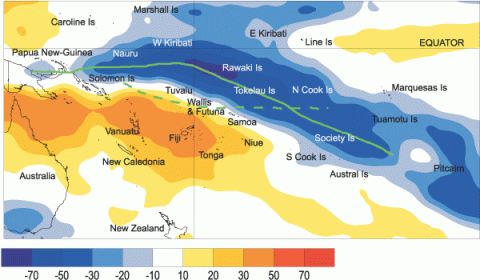Climate developments in February 2005
There was a marked dipole in convection and very anomalous outgoing longwave radiation (OLR) over the Southwest Pacific in February. Strongly suppressed convection occurred over much of Australia and Indonesia, as well as Vanuatu, New Caledonia, and much of Fiji. Very enhanced convection occurred, associated with the South Pacific Convergence Zone (SPCZ) and the occurrence of several tropical cyclones, which extended from the east of the Solomon Islands to the region between Western Kiribati and Tuvalu and then southeast through Tokelau toward the Society Islands of French Polynesia. The OLR anomaly was the strongest in the region for several years, showing a clear northeastward movement and strengthening in the SPCZ. Enhanced convergence also affected the Caroline and Marshall Islands north of the Equator, as well as the Northern Cook Islands and Pitcairn Island.
Rainfall was at least 125% of average in much of Tuvalu, Tokelau, and the Southern Cook Islands, and more than 200% of average in parts of Fiji’s Northern Division and Northern and Central French Polynesia. Rainfall was less than 50% of average in the Coral Sea, New Caledonia, central and southern parts of Fiji, and also below average in Tonga.
It was slightly warmer than usual throughout much of the Southwest Pacific in February. Mean air temperatures were about 0.8°C above average in New Caledonia, and 1.0°C above average in Samoa. Temperatures were below average in Southern French Polynesia. Tropical Southwest Pacific mean sea-level pressures continued above average well west of the Date Line. They also continued below average in the east, especially near the Southern Cook Islands, where they were more than 7 hPa below average (as a result of several tropical cyclones). Rarotonga’s monthly mean MSL pressure of 1006.8 hPa (5 hPa below normal) was the lowest there for any month, in records that commenced in 1935.
Further east, Tahiti’s monthly mean sea-level pressure of 1007.3 hPa was the lowest for February in records which commenced in 1876. Along the Equator, surface equatorial westerlies occurred in 40% of observations at Tarawa, their highest frequency since the end of the last moderate El Niño in November 2002.
Climate extremes in February 2005
| Country | Location | Rainfall (mm) | % of average | Comments |
|---|---|---|---|---|
| Fiji | Udu Point | 732 | 294 | Extremely high |
| French Polynesia | Hiva Hoa, Atuona | 207 | 249 | Well above average |
| French Polynesia | Tahiti-Faaa | 729 | 330 | Extremely high |
| French Polynesia | Tuamotu, Takaroa | 492 | 286 | Record high |
| New Caledonia | Belep | 48 | 24 | Well below average |
| New Caledonia | La Roche | 40 | 19 | Extremely low |
| Fiji | Nadi Airport | 64 | 22 | Well below average |
| Fiji | Ono-I-Lau | 24 | 12 | Well below average |
| Fiji | Matuku | 17 | 9 | Extremely low |

